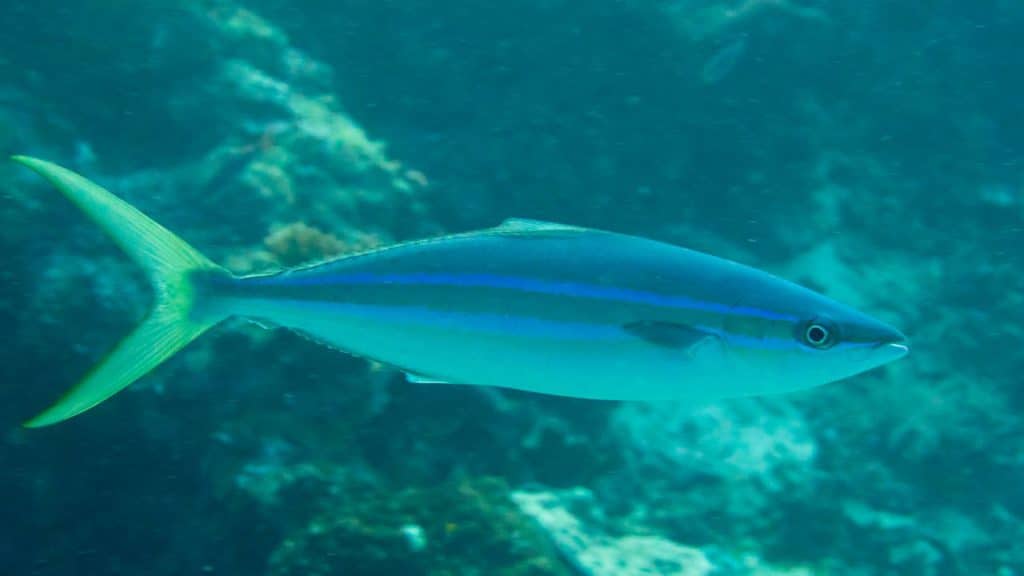The rainbow runner got its name from its bright and vibrant coloration. It has a blue-green sheen on its back, with silvery sides and a yellow underside. But did you know that it has seven spines – six of which are at its first dorsal fin, and the last one is at its second dorsal fin?
You will learn more about its physical characteristics, habitat, behavior, conservation status, and even the best live bait to use.
Fish Profile: Rainbow Runner Overview

| Scientific Name | Elagatis bipinnulata |
| Other names | Spanish Jack, Hawaiian Salmon, Rainbow Yellowtail |
| Family | Carangidae |
| Appearance | Blue-green sheen on its back, with silvery sides and a yellow underside |
| Ave. weight and length | 50-60 cm (20-24 inches), up to 9 kg (20 pounds) |
| Habitat | Tropical and subtropical oceans |
| Diet | Small crustaceans and fish |
| Spawning season | Year-round. Peak season during spring to autumn in the Atlantic ocean, May and December–January in the Western Pacific Ocean |
| Behavior | Fast surface runs, tough fighter |
| Depth range | 0 – 150m |
| Conservation status | Least concern |
What is A Rainbow Runner Fish?
It is a type of pelagic fish that belongs to the family Carangidae, which includes other popular game fish such as tuna, mackerel, and jacks. It is scientifically known as Elagatis bipinnulata. You can find them in the tropical and subtropical waters of the Indian and Pacific Oceans.
This fish is closely related to the California yellowtail, another popular game fish found in the waters off the coast of California. Both species are known for their tough fighting spirit and acrobatic leaps when caught on a line, making them excellent gamefish for recreational anglers.
Besides its scientific name, the fish is also known by various other names, including Hawaiian salmon, rainbow yellowtail, or Spanish jack. These names refer to the fish’s bright and vibrant coloration, characterized by a blue-green sheen on its back, silvery sides, and a yellow underside.
Where Are They Found?
You can find adult Spanish jacks in the tropical and subtropical waters of the world, including the Pacific and Indian Oceans. They are also found in the southern Gulf of Mexico and the Bahamas.
Rainbow yellowtails often swim near floating debris or in areas with strong currents.
Rain yellowtails are highly migratory, so their distribution can depend on the time of year and the water temperature. However, they are more likely to be found in areas with warm water. During the summer months, they move to deeper, cooler waters.
What Do They Look Like?
You can identify a Spanish jack by its bright and vibrant color. The fish has a blue-green sheen on its back and silvery sides, with a yellow underside. It also has a long and slender body and a forked tail fin.
Rainbow yellowtails have two dorsal fins, the first of which has six spines and the second of which has just one. They also have an anal fin and a pair of pectoral fins located on the body’s sides. The fish’s belly is typically white and may also have light blue stripes running horizontally along its sides.
In terms of size, rainbow yellowtail can grow quite large. They can reach up to 90 cm (35 inches) in length and weigh up to 9 kg (20 pounds). However, most rainbow yellowtails caught by anglers are typically smaller, averaging around 50-60 cm (20-24 inches) in length.
What Do They Eat?
Spanish jacks feed on a variety of small crustaceans and fish, including shrimp, crabs, worms, squid, and small baitfish. They also feed on algae, plankton, and other plant material.
Fun Fact: They hunt in schools and chase their prey. They feed near the surface, usually in shallow waters, but may swim down to depths of 90 feet or more.
How Do They Reproduce?
Spanish jacks reproduce by spawning, which releases eggs and sperm into the water to fertilize them. Spawning typically occurs in the summer months and is triggered by a combination of factors, including water temperature and photoperiod (the length of daylight).
Adult rainbow runners will form large aggregations near reefs, lagoons, and other sheltered areas.
Once the eggs are fertilized, they will hatch into larvae, which are small, transparent, and heavily pigmented. The larvae will then develop into juvenile rainbow yellowtails, eventually reaching adulthood and reproducing themselves.
FAQ
Are Rainbow Runners Good to Eat?
Yes, Spanish jacks are good to eat. They are mild-flavored, firm-textured, and versatile, making them great for various dishes. In terms of nutrition, rainbow yellowtails are rich in protein, omega-3 fatty acids, and other essential vitamins and minerals.
What Does Rainbow Runner Fish Taste Like?
In terms of taste, Spanish jacks are known for their moist and flaky flesh. The flavor of the fish can vary depending on how it is prepared and cooked, but it is generally described as delicate and mildly sweet. You can cook rainbow yellowtails in various ways, including grilling, baking, frying, and smoking. They are often used in sushi, sashimi, ceviche, and fish tacos.
How Do You Catch a Rainbow Runner?
You can catch a rainbow yellowtail using a wide range of lures, including plugs, soft plastic lures, and poppers. These lures can mimic the appearance and movements of the rainbow yellowtail’s natural prey, making them more attractive to the fish.
It is essential to use a lighter tackle when fishing for rainbow yellowtails, as they are known for their strong fighting spirit and acrobatic leaps when caught on a line. A heavy tackle can break the line or tire out the fish more quickly, leading to a longer and more stressful release process.
Table of Contents



